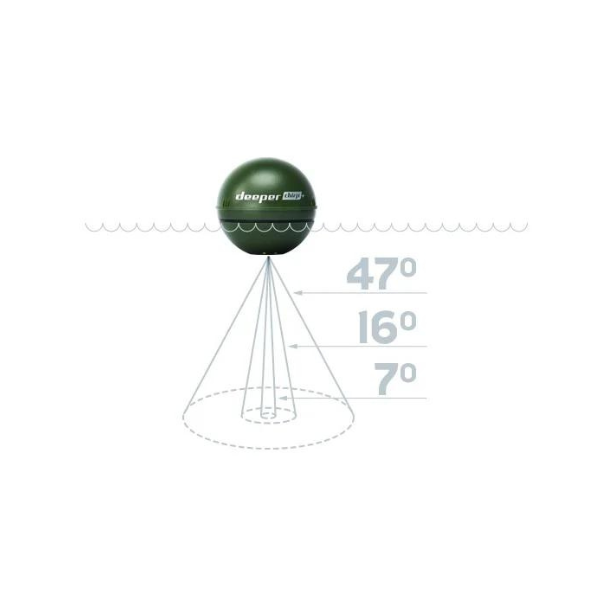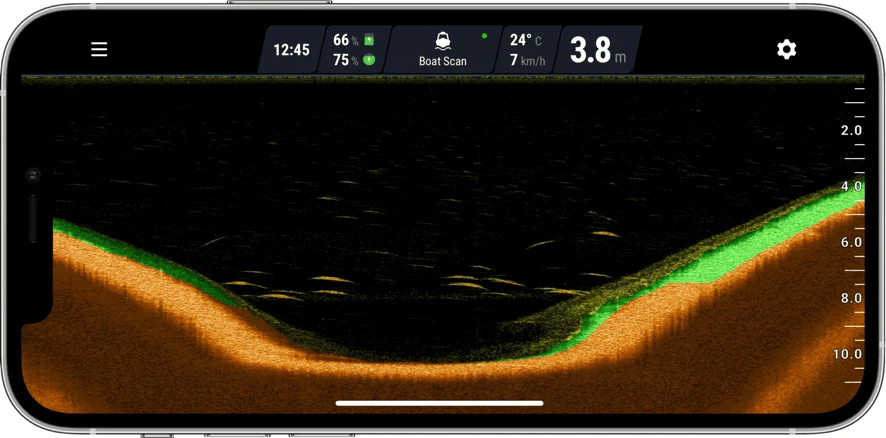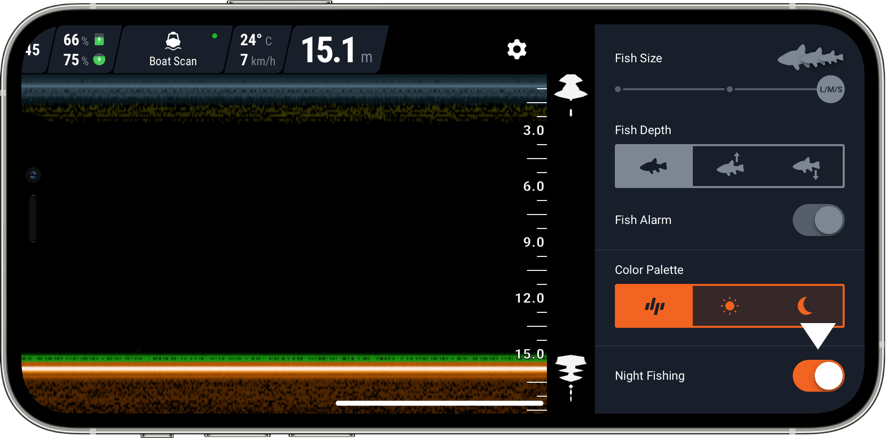Deeper Smart Sonar Set Up
and use the data to catch more and catch bigger

Look at your smart sonar as a device of many uses, a device that needs adjusting as conditions dictate. Unless you own a unit that comes from the factory with pre-programmed setting (Deeper START), you'll be able to customize your sonar to your exact fishing needs.
Fishing/Scanning modes
The way your sonar readings are shown on screen will vary depending on the display options and sonar mode you select. To change the sonar mode, go to Settings in the top menu bar and find the Sonar mode section. Each mode is described in detail below.
Collapsible content

For boat or kayak fishing use Boat Mode
In this mode, the Fish Deeper App instantly connects to the GPS in your smartphone or tablet to create real-time bathymetric maps. You will see the sonar returns on the right side of the screen and the map on the left (Settings > Sonar Mode > Boat Mode).
For shore fishing PRO+ 2/CHIRP+ 2 users should choose Onshore GPS Mode
Onshore GPS Mode operates in the same manner as Boat Mode, but instead of using your smartphone’s GPS, Onshore GPS Mode uses the internal GPS receiver installed in the Deeper PRO+ 2/CHIRP+ 2. You will see the sonar returns on the right side of the screen and the map on the left(Settings > Sonar Mode > Onshore GPS Mode).
For shore fishing with PRO use Show Scan Only Mode
The sonar return will be full screen. Bathymetric maps will not be created when shore fishing with a PRO model.
For ice fishing use Ice Fishing Mode
It has a traditional ice fishing flasher display on the left and a vertical flasher displayed on the right. It lets you track the movement of even the smallest lure or bait in real time. In Ice fishing mode the Fish Deeper App will record and save all the ice holes you fish directly onto an expandable map on the left side of the screen.
Screen Adjustments and Alarms
Adjusting your screen and alarms will help you set up your Deeper sonar for the most effective fishing.
Beam Angle/Frequency
To understand beams better, think of narrow vs wide beam as flashlight vs floodlight. Like a flashlight beam, a narrow transducer cone shoots directly under the sonar. But, like a floodlight, a wider cone finds more fish off to the side.

Beam Angle
Choosing the correct beam angle will have a great impact on your sonar performance. Deeper PRO has 2 frequencies/scanning angles: Narrow 290 kHz (15º) and Wide 90 kHz (55º). Deeper PRO+ 2 and CHIRP+ 2 have 3 frequencies/scanning angles: Narrow 675 KHz (7º), Mid 240 kHz (20º), Wide 100 kHz (47º).
Collapsible content
For PRO users:
Start with the wide angle to scan a larger area faster. Change to narrow beam to inspect the area in more detail. Narrow beam is the best for shallow waters <1.5m, places with lots of vegetation, scanning above a school of fish, in depths greater than 20m and steep drops (to avoid a larger blind zone).
For Deeper PRO+ 2 and CHIRP+ 2 users:
Use wide beam to find a good fishing spot and scan the area faster. Switch to mid beam PRO+ 2/CHIRP+ 2 to drill in on that hotspot you've located. Additionally, Deeper PRO+ 2/CHIRP+ 2 have a very narrow beam, scanning angle of 7º, which can show a massive amount of detail. Narrow beam is very sensitive to all external factors: wind and waves, trolling, reeling, etc. It performs best in calm water or when fixed to a boat using the flex arm mount.
Tip:
If you see too much clutter and reducing sensitivity does not help, change the angle to a wider one.

Cone Diameter
Cone diameter depends on the cone angle and fishing depth. For example, if you are fishing in 10m depth, the cone diameter with PRO narrow beam will be 2.5m and for CHIRP+ 2, it will be 1.2m. The smaller the diameter, the better you can determine where the fish are located. You can calculate cone diameter by using this formula: Sonar Cone Diameter = 2depthTan(cone angle/2). Example: CHIRP+ 2 narrow angle beam diameter in 10m depth. Depth = 10m; Cone Angle = 7º, 1.22 = 2*10Tan(7/2)

Sensitivity
Sensitivity is like volume control on a hearing aid, it is the sonar‘s ability to receive echoes. Beginning anglers often set their sonar sensitivity too low. They like a nice, clean screen. Pro anglers set the sensitivity high – 70% to 90% of the maximum. They tolerate more clutter. That’s why they see more fish. The best strategy is setting the sensitivity to 100%, then backing off until you‘re satisfied with your screen‘s appearance.
If the clutter runs deep, reduce sensitivity until the clutter lessens, yet fish remain. If this doesn’t work, switch to lower frequency wide beam. No matter where you set the sensitivity, your sonar sends out the same amount of power. Sensitivity just controls how much the sonar amplifies each returning signal.
This might sound like a lot of work, but it’s not. Most of these settings we only need to adjust right before fishing. Others, only when dark clouds appear, or when we change our method of fishing. Granted, you are on the water to fish, not fiddle with gadgets. If you take the time to master your sonar features, you’ll fish more effectively. Tight lines!


